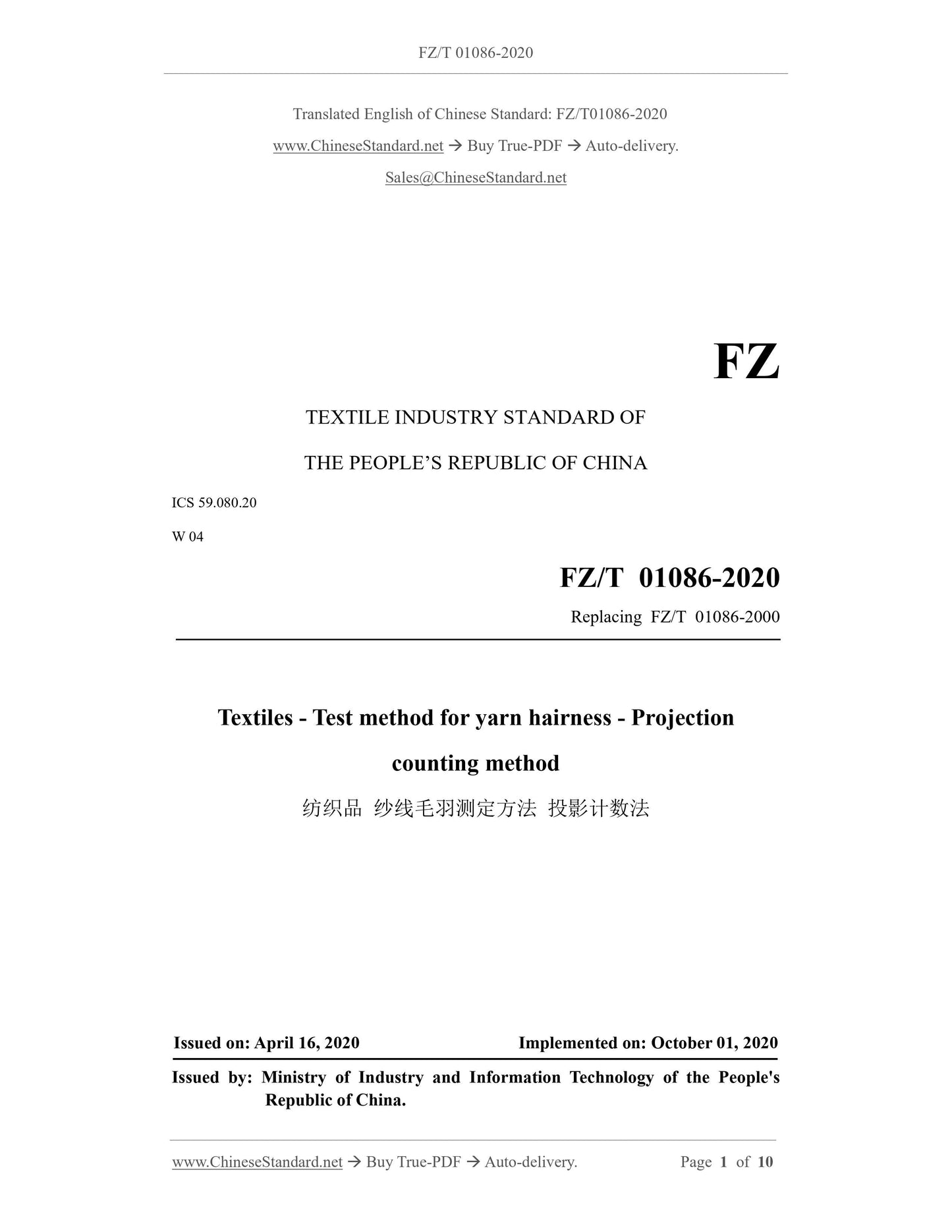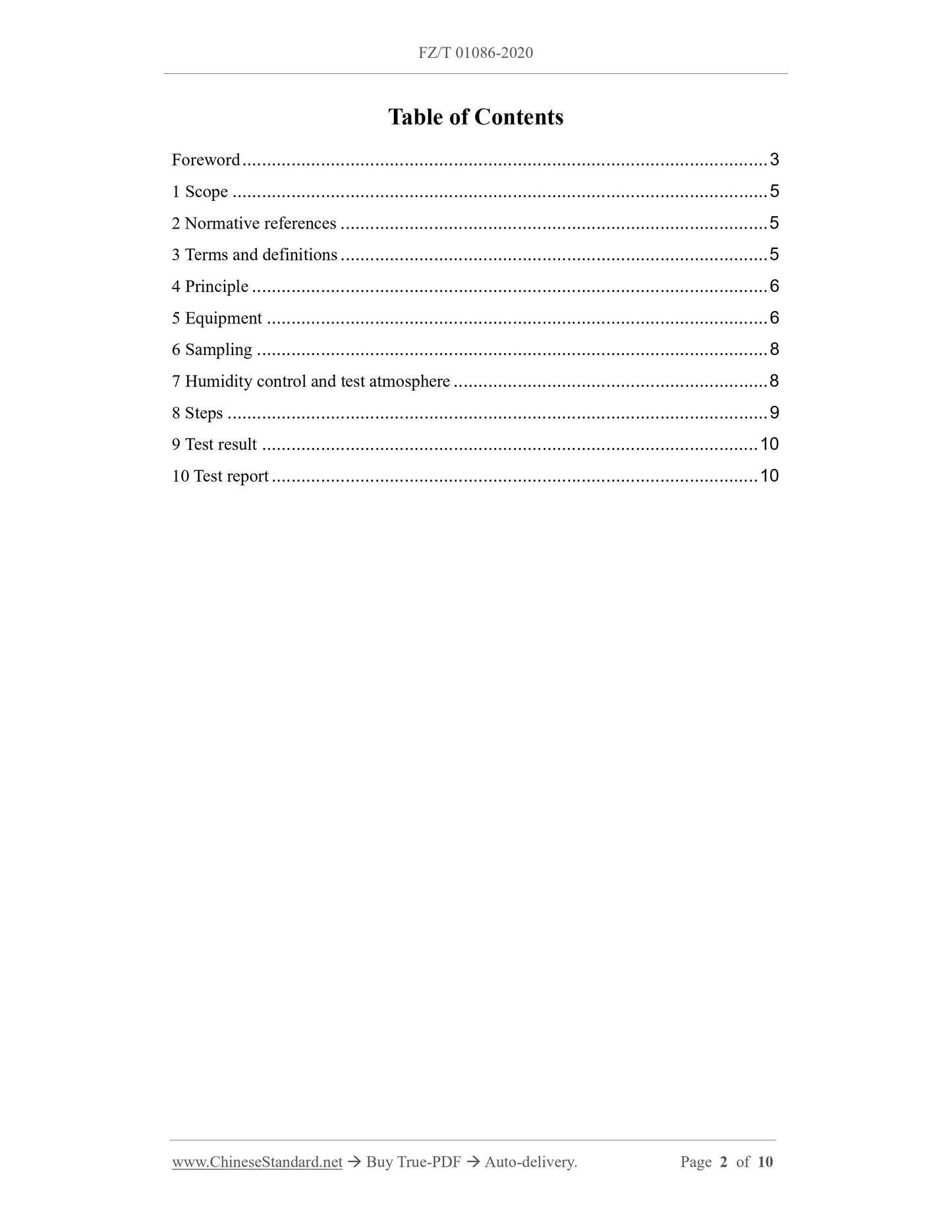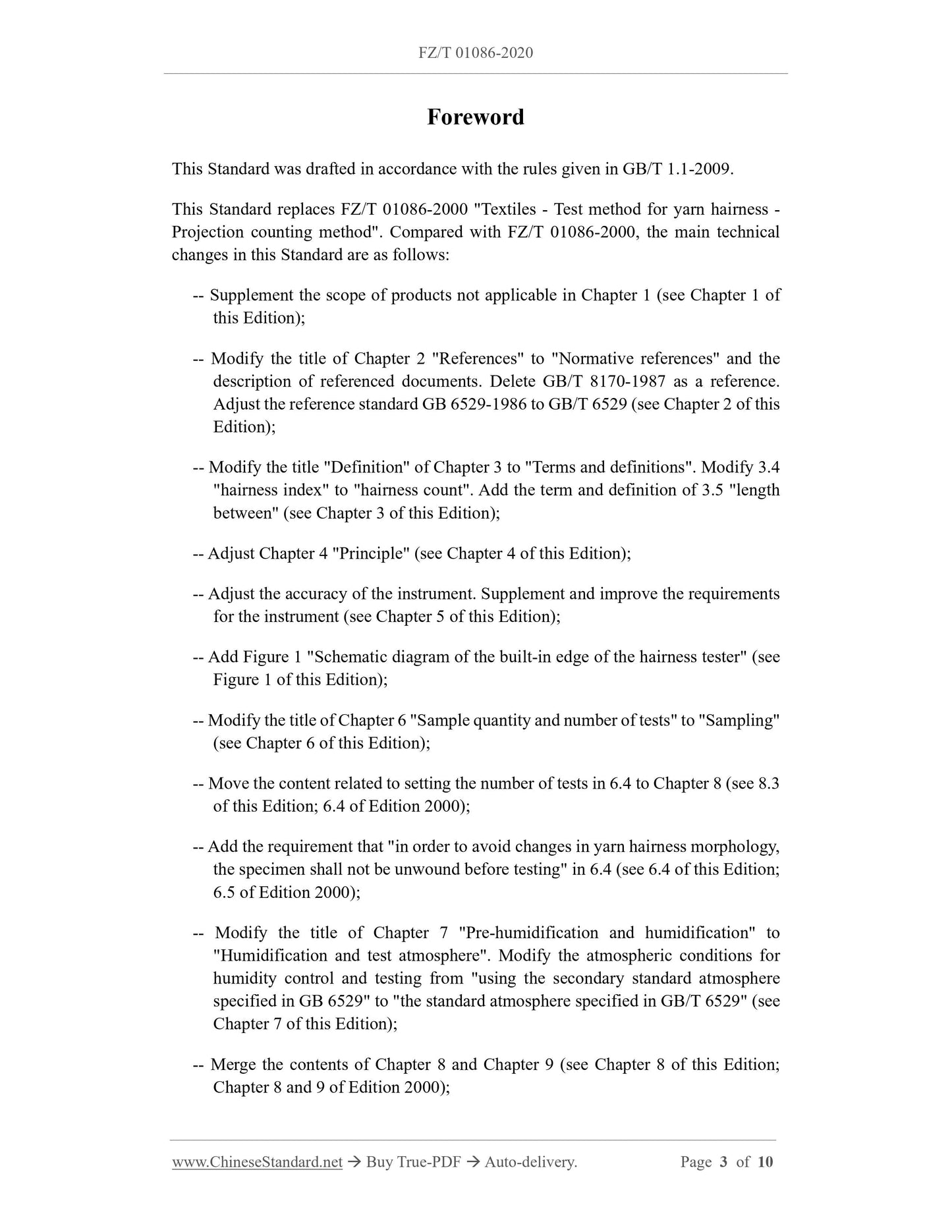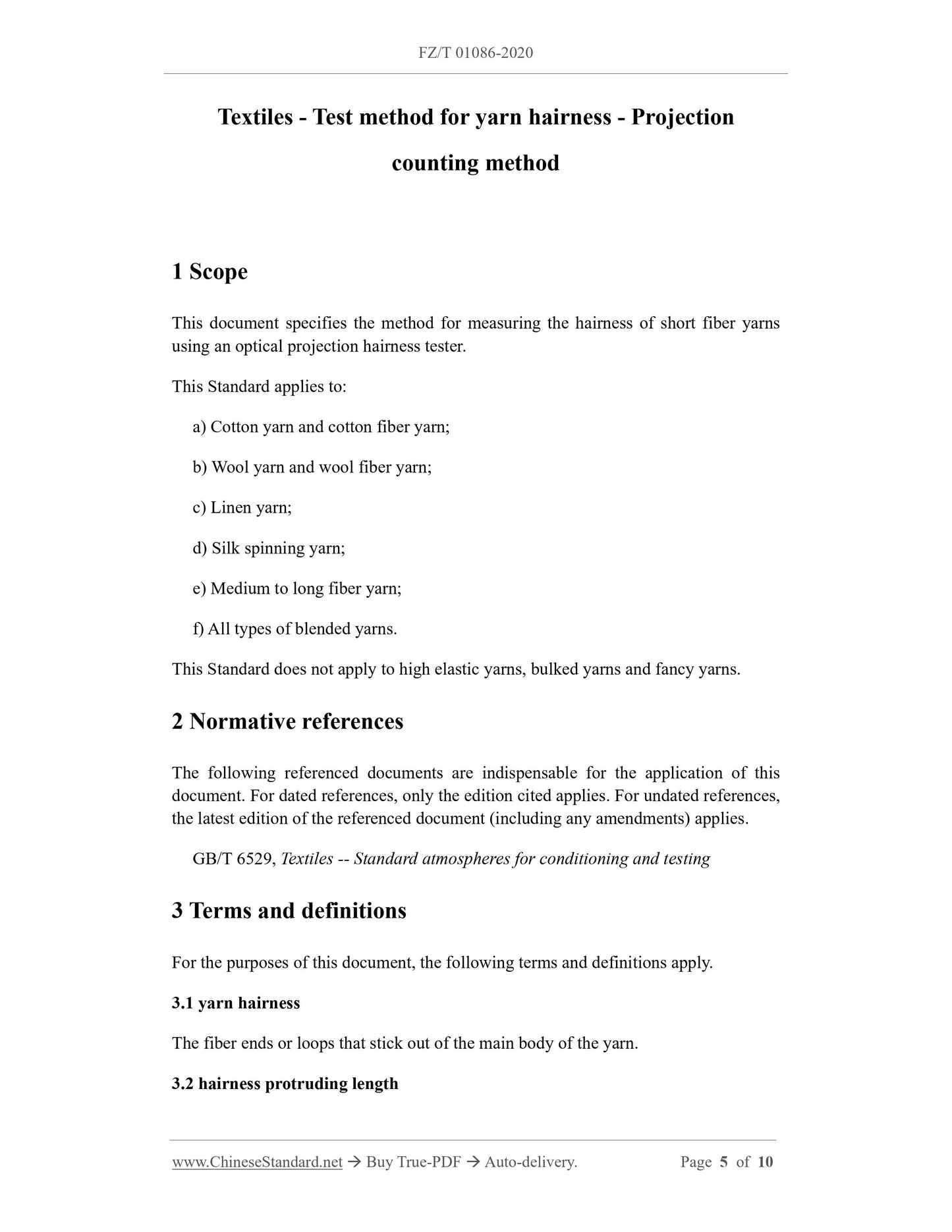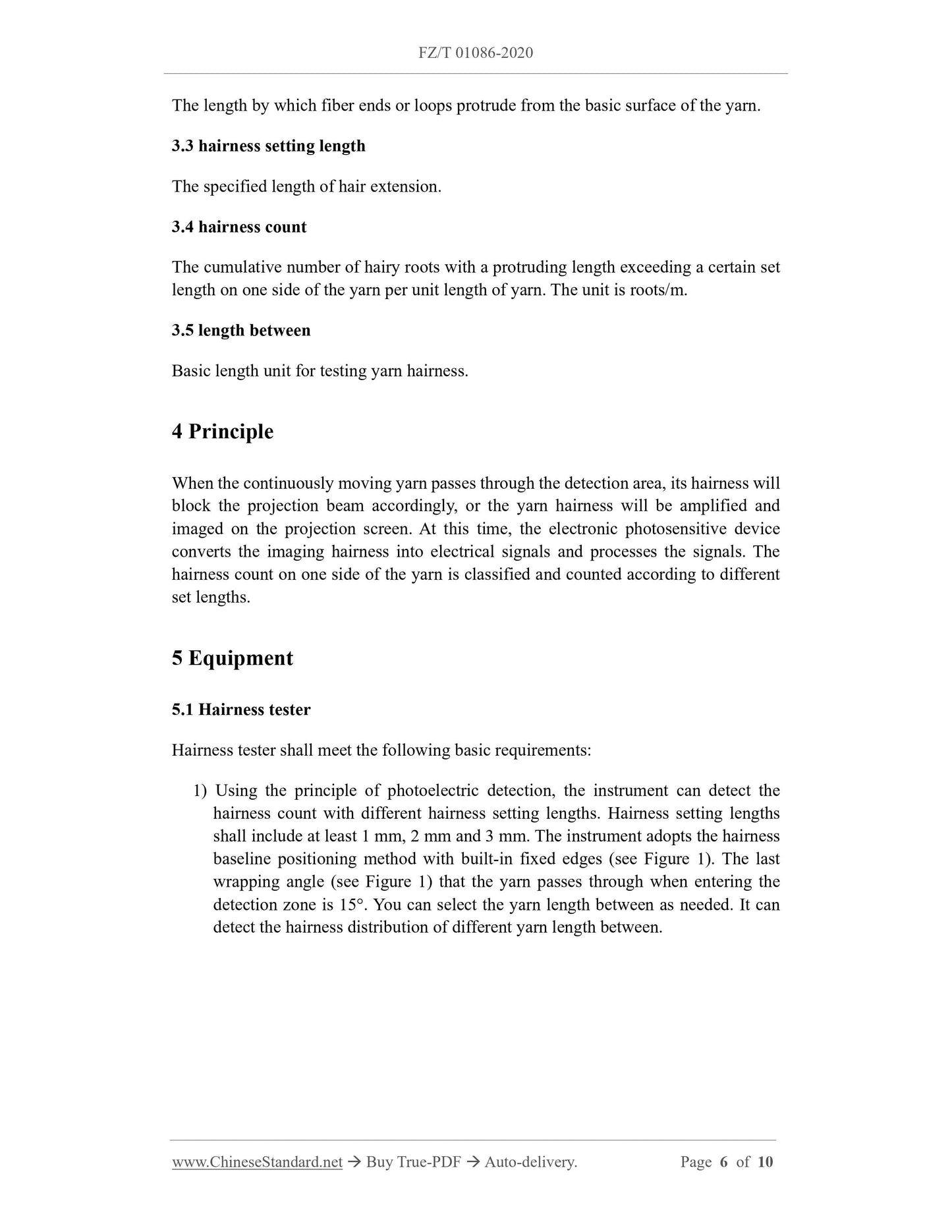1
/
의
5
PayPal, credit cards. Download editable-PDF and invoice in 1 second!
FZ/T 01086-2020 English PDF (FZT01086-2020)
FZ/T 01086-2020 English PDF (FZT01086-2020)
정가
$125.00 USD
정가
할인가
$125.00 USD
단가
/
단위
배송료는 결제 시 계산됩니다.
픽업 사용 가능 여부를 로드할 수 없습니다.
Delivery: 3 seconds. Download true-PDF + Invoice.
Get QUOTATION in 1-minute: Click FZ/T 01086-2020
Historical versions: FZ/T 01086-2020
Preview True-PDF (Reload/Scroll if blank)
FZ/T 01086-2020: Textiles - Test method for yarn hairness - Projection counting method
FZ/T 01086-2020
FZ
TEXTILE INDUSTRY STANDARD OF
THE PEOPLE’S REPUBLIC OF CHINA
ICS 59.080.20
W 04
Replacing FZ/T 01086-2000
Textiles - Test method for yarn hairness - Projection
counting method
ISSUED ON: APRIL 16, 2020
IMPLEMENTED ON: OCTOBER 01, 2020
Issued by: Ministry of Industry and Information Technology of the People's
Republic of China.
Table of Contents
Foreword ... 3
1 Scope ... 5
2 Normative references ... 5
3 Terms and definitions ... 5
4 Principle ... 6
5 Equipment ... 6
6 Sampling ... 8
7 Humidity control and test atmosphere ... 8
8 Steps ... 9
9 Test result ... 10
10 Test report ... 10
Foreword
This Standard was drafted in accordance with the rules given in GB/T 1.1-2009.
This Standard replaces FZ/T 01086-2000 "Textiles - Test method for yarn hairness -
Projection counting method". Compared with FZ/T 01086-2000, the main technical
changes in this Standard are as follows:
-- Supplement the scope of products not applicable in Chapter 1 (see Chapter 1 of
this Edition);
-- Modify the title of Chapter 2 "References" to "Normative references" and the
description of referenced documents. Delete GB/T 8170-1987 as a reference.
Adjust the reference standard GB 6529-1986 to GB/T 6529 (see Chapter 2 of this
Edition);
-- Modify the title "Definition" of Chapter 3 to "Terms and definitions". Modify 3.4
"hairness index" to "hairness count". Add the term and definition of 3.5 "length
between" (see Chapter 3 of this Edition);
-- Adjust Chapter 4 "Principle" (see Chapter 4 of this Edition);
-- Adjust the accuracy of the instrument. Supplement and improve the requirements
for the instrument (see Chapter 5 of this Edition);
-- Add Figure 1 "Schematic diagram of the built-in edge of the hairness tester" (see
Figure 1 of this Edition);
-- Modify the title of Chapter 6 "Sample quantity and number of tests" to "Sampling"
(see Chapter 6 of this Edition);
-- Move the content related to setting the number of tests in 6.4 to Chapter 8 (see 8.3
of this Edition; 6.4 of Edition 2000);
-- Add the requirement that "in order to avoid changes in yarn hairness morphology,
the specimen shall not be unwound before testing" in 6.4 (see 6.4 of this Edition;
6.5 of Edition 2000);
-- Modify the title of Chapter 7 "Pre-humidification and humidification" to
"Humidification and test atmosphere". Modify the atmospheric conditions for
humidity control and testing from "using the secondary standard atmosphere
specified in GB 6529" to "the standard atmosphere specified in GB/T 6529" (see
Chapter 7 of this Edition);
-- Merge the contents of Chapter 8 and Chapter 9 (see Chapter 8 of this Edition;
Chapter 8 and 9 of Edition 2000);
Textiles - Test method for yarn hairness - Projection
counting method
1 Scope
This document specifies the method for measuring the hairness of short fiber yarns
using an optical projection hairness tester.
This Standard applies to:
a) Cotton yarn and cotton fiber yarn;
b) Wool yarn and wool fiber yarn;
c) Linen yarn;
d) Silk spinning yarn;
e) Medium to long fiber yarn;
f) All types of blended yarns.
This Standard does not apply to high elastic yarns, bulked yarns and fancy yarns.
2 Normative references
The following referenced documents are indispensable for the application of this
document. For dated references, only the edition cited applies. For undated references,
the latest edition of the referenced document (including any amendments) applies.
GB/T 6529, Textiles -- Standard atmospheres for conditioning and testing
3 Terms and definitions
For the purposes of this document, the following terms and definitions apply.
3.1 yarn hairness
The fiber ends or loops that stick out of the main body of the yarn.
3.2 hairness protruding length
The length by which fiber ends or loops protrude from the basic surface of the yarn.
3.3 hairness setting length
The specified length of hair extension.
3.4 hairness count
The cumulative number of hairy roots with a protruding length exceeding a certain set
length on one side of the yarn per unit length of yarn. The unit is roots/m.
3.5 length between
Basic length unit for testing yarn hairness.
4 Principle
When the continuously moving yarn passes through the detection area, its hairness will
block the projection beam accordingly, or the yarn hairness will be amplified and
imaged on the projection screen. At this time, the electronic photosensitive device
converts the imaging hairness into electrical signals and processes the signals. The
hairness count on one side of the yarn is classified and counted according to different
set lengths.
5 Equipment
5.1 Hairness tester
Hairness tester shall meet the following basic requirements:
1) Using the principle of photoelectric detection, the instrument can detect the
hairness count with different hairness setting lengths. Hairness setting lengths
shall include at least 1 mm, 2 mm and 3 mm. The instrument adopts the hairness
baseline positioning method with built-in fixed edges (see Figure 1). The last
wrapping angle (see Figure 1) that the yarn passes through when entering the
detection zone is 15°. You can select the yarn length between as needed. It can
detect the hairness distribution of different yarn length between.
Get QUOTATION in 1-minute: Click FZ/T 01086-2020
Historical versions: FZ/T 01086-2020
Preview True-PDF (Reload/Scroll if blank)
FZ/T 01086-2020: Textiles - Test method for yarn hairness - Projection counting method
FZ/T 01086-2020
FZ
TEXTILE INDUSTRY STANDARD OF
THE PEOPLE’S REPUBLIC OF CHINA
ICS 59.080.20
W 04
Replacing FZ/T 01086-2000
Textiles - Test method for yarn hairness - Projection
counting method
ISSUED ON: APRIL 16, 2020
IMPLEMENTED ON: OCTOBER 01, 2020
Issued by: Ministry of Industry and Information Technology of the People's
Republic of China.
Table of Contents
Foreword ... 3
1 Scope ... 5
2 Normative references ... 5
3 Terms and definitions ... 5
4 Principle ... 6
5 Equipment ... 6
6 Sampling ... 8
7 Humidity control and test atmosphere ... 8
8 Steps ... 9
9 Test result ... 10
10 Test report ... 10
Foreword
This Standard was drafted in accordance with the rules given in GB/T 1.1-2009.
This Standard replaces FZ/T 01086-2000 "Textiles - Test method for yarn hairness -
Projection counting method". Compared with FZ/T 01086-2000, the main technical
changes in this Standard are as follows:
-- Supplement the scope of products not applicable in Chapter 1 (see Chapter 1 of
this Edition);
-- Modify the title of Chapter 2 "References" to "Normative references" and the
description of referenced documents. Delete GB/T 8170-1987 as a reference.
Adjust the reference standard GB 6529-1986 to GB/T 6529 (see Chapter 2 of this
Edition);
-- Modify the title "Definition" of Chapter 3 to "Terms and definitions". Modify 3.4
"hairness index" to "hairness count". Add the term and definition of 3.5 "length
between" (see Chapter 3 of this Edition);
-- Adjust Chapter 4 "Principle" (see Chapter 4 of this Edition);
-- Adjust the accuracy of the instrument. Supplement and improve the requirements
for the instrument (see Chapter 5 of this Edition);
-- Add Figure 1 "Schematic diagram of the built-in edge of the hairness tester" (see
Figure 1 of this Edition);
-- Modify the title of Chapter 6 "Sample quantity and number of tests" to "Sampling"
(see Chapter 6 of this Edition);
-- Move the content related to setting the number of tests in 6.4 to Chapter 8 (see 8.3
of this Edition; 6.4 of Edition 2000);
-- Add the requirement that "in order to avoid changes in yarn hairness morphology,
the specimen shall not be unwound before testing" in 6.4 (see 6.4 of this Edition;
6.5 of Edition 2000);
-- Modify the title of Chapter 7 "Pre-humidification and humidification" to
"Humidification and test atmosphere". Modify the atmospheric conditions for
humidity control and testing from "using the secondary standard atmosphere
specified in GB 6529" to "the standard atmosphere specified in GB/T 6529" (see
Chapter 7 of this Edition);
-- Merge the contents of Chapter 8 and Chapter 9 (see Chapter 8 of this Edition;
Chapter 8 and 9 of Edition 2000);
Textiles - Test method for yarn hairness - Projection
counting method
1 Scope
This document specifies the method for measuring the hairness of short fiber yarns
using an optical projection hairness tester.
This Standard applies to:
a) Cotton yarn and cotton fiber yarn;
b) Wool yarn and wool fiber yarn;
c) Linen yarn;
d) Silk spinning yarn;
e) Medium to long fiber yarn;
f) All types of blended yarns.
This Standard does not apply to high elastic yarns, bulked yarns and fancy yarns.
2 Normative references
The following referenced documents are indispensable for the application of this
document. For dated references, only the edition cited applies. For undated references,
the latest edition of the referenced document (including any amendments) applies.
GB/T 6529, Textiles -- Standard atmospheres for conditioning and testing
3 Terms and definitions
For the purposes of this document, the following terms and definitions apply.
3.1 yarn hairness
The fiber ends or loops that stick out of the main body of the yarn.
3.2 hairness protruding length
The length by which fiber ends or loops protrude from the basic surface of the yarn.
3.3 hairness setting length
The specified length of hair extension.
3.4 hairness count
The cumulative number of hairy roots with a protruding length exceeding a certain set
length on one side of the yarn per unit length of yarn. The unit is roots/m.
3.5 length between
Basic length unit for testing yarn hairness.
4 Principle
When the continuously moving yarn passes through the detection area, its hairness will
block the projection beam accordingly, or the yarn hairness will be amplified and
imaged on the projection screen. At this time, the electronic photosensitive device
converts the imaging hairness into electrical signals and processes the signals. The
hairness count on one side of the yarn is classified and counted according to different
set lengths.
5 Equipment
5.1 Hairness tester
Hairness tester shall meet the following basic requirements:
1) Using the principle of photoelectric detection, the instrument can detect the
hairness count with different hairness setting lengths. Hairness setting lengths
shall include at least 1 mm, 2 mm and 3 mm. The instrument adopts the hairness
baseline positioning method with built-in fixed edges (see Figure 1). The last
wrapping angle (see Figure 1) that the yarn passes through when entering the
detection zone is 15°. You can select the yarn length between as needed. It can
detect the hairness distribution of different yarn length between.
Share
